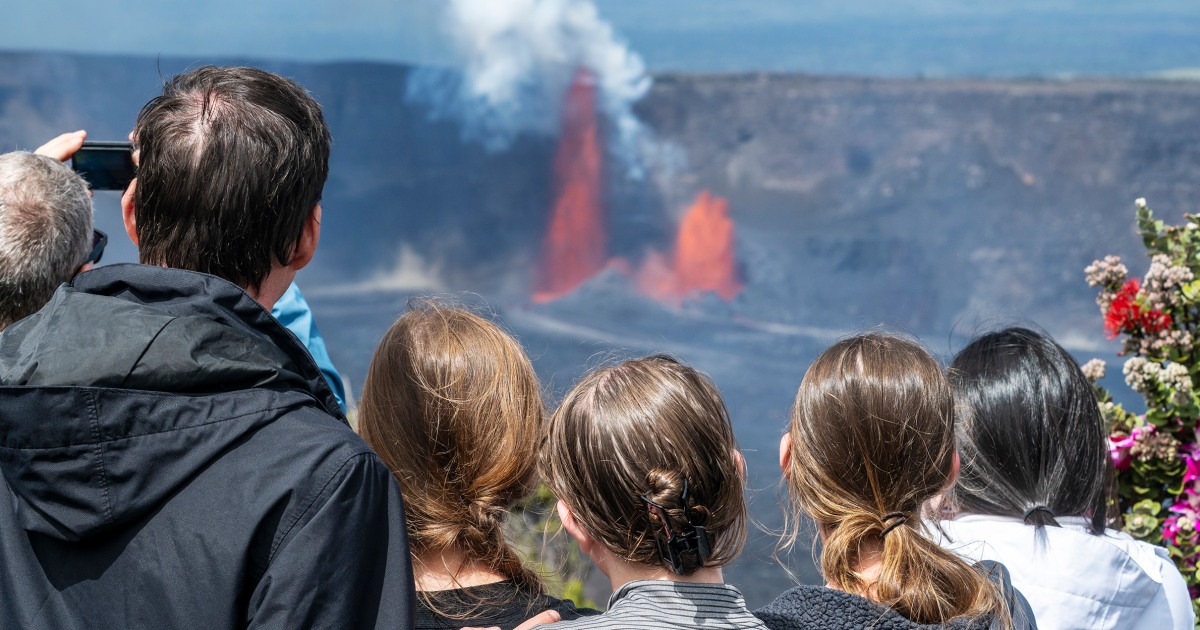Kilauea’s Spectacular Eruption: An Awe-Inspiring Show of Nature’s Fury
Hawaii’s Kilauea volcano captivates onlookers with a mesmerizing display of towering lava fountains, showcasing the raw power of nature. As the eruption unfolds, scientists and tourists alike are drawn to witness this breathtaking spectacle. The Kilauea eruption is not just a geological event; it represents a complex interplay between the Earth’s inner workings and the surface environment, offering a unique spectacle that enchants and educates.
The Science Behind Kilauea’s Eruptions
Kilauea, one of the most active volcanoes in the world, is located on the Big Island of Hawaii. It has been erupting intermittently since 1983, with significant eruptions occurring in 2018 and more recently in 2023. The volcano is classified as a shield volcano, characterized by its broad, gently sloping sides formed by the flow of low-viscosity lava.
The driving force behind Kilauea’s eruptions is the movement of tectonic plates in the Pacific region. As the Pacific Plate moves over a hotspot in the Earth’s mantle, magma rises to the surface, leading to volcanic activity. The current eruptive phase has been marked by spectacular lava fountains and extensive lava flows, which can reach heights of over 300 feet.
Witnessing the Eruption: A Visitor’s Perspective
For many, witnessing Kilauea’s spectacular eruption is a once-in-a-lifetime experience. Tourists flock to the Hawaii Volcanoes National Park, where they can safely observe the volcanic activity from designated viewpoints. The sight of glowing red lava bubbling and spewing into the air is nothing short of mesmerizing.
- Safety First: Visitors are advised to adhere to all park safety guidelines. Eruptions can be unpredictable, and it’s crucial to stay informed through park alerts and ranger briefings.
- Best Viewing Times: The best time to witness the eruption is at night when the glow from the lava is most visible against the dark sky.
- Photography Tips: For those looking to capture the moment, using a tripod and long exposure settings can help create stunning images of the flowing lava and fountains.
Many visitors leave with a renewed appreciation for the power of nature. As you stand at a safe distance, feeling the warmth radiating from the lava, it’s a humbling reminder of the Earth’s ever-changing landscape.
The Environmental Impact of Kilauea’s Eruptions
While the eruption of Kilauea is a sight to behold, it also raises important questions about environmental impact. The release of volcanic gases, such as sulfur dioxide, can affect air quality and contribute to the formation of vog (volcanic smog). This can have health implications for residents and visitors, particularly those with respiratory conditions.
Furthermore, lava flows can reshape the landscape significantly, leading to the destruction of vegetation and wildlife habitats. However, Kilauea’s eruptions also create new land, as lava cools and solidifies, contributing to the ongoing growth of the Hawaiian Islands.
The Cultural Significance of Kilauea
Kilauea holds deep cultural significance for the Native Hawaiian people. It is considered a sacred site, embodying the spiritual connection between the land and its inhabitants. The volcano is associated with Pele, the Hawaiian goddess of fire and volcanoes, who is revered in many local myths and legends. Understanding this cultural context adds depth to the experience of witnessing an eruption.
The Hawaiian culture teaches respect for nature and emphasizes the importance of living in harmony with the environment. This perspective encourages a broader understanding of the volcanic activity, seeing it not just as a natural phenomenon but as a vital part of the cultural landscape.
Scientific Research and Monitoring
The Kilauea eruption presents unique opportunities for scientific research. Volcanologists study the eruption dynamics, gas emissions, and lava flow patterns to better understand not only Kilauea but also volcanic systems worldwide. The data collected during eruptions contribute to improved predictive models, which can help mitigate risks associated with volcanic activity.
Scientists utilize various technologies, including satellite imagery, drones, and ground-based sensors, to monitor changes in the volcano’s behavior. This continuous monitoring is crucial for ensuring the safety of nearby communities and enhancing our understanding of volcanic processes.
How to Prepare for a Visit to Kilauea
If you’re planning to witness Kilauea’s spectacular eruption, preparation is key. Here are some tips to ensure a safe and enjoyable experience:
- Check Conditions: Before your visit, check the National Park Service website for the latest updates on eruption activity and park accessibility.
- Dress Appropriately: Wear sturdy shoes and layered clothing, as temperatures can vary significantly, especially at night.
- Bring Supplies: Carry water, snacks, and a flashlight. If you plan to stay after dark, a headlamp can be very helpful.
In addition to the eruption, the park offers numerous hiking trails, scenic drives, and visitor centers that provide insights into the geology and ecology of the area. This combination of natural beauty and educational opportunities makes a visit to Kilauea a multifaceted experience.
Conclusion: Embracing Nature’s Theater
Kilauea’s spectacular eruption is more than just a visual feast; it’s a reminder of the dynamic forces shaping our planet. Whether you’re a scientist, a traveler, or a local resident, witnessing this natural phenomenon can be a transformative experience. The eruption serves as a powerful representation of nature’s ability to inspire awe and respect.
As we continue to learn from Kilauea’s eruptions, we are reminded of our place within the natural world. By embracing this connection, we can foster a greater appreciation for the environment and the majestic forces that govern it.
See more Your Daily Weather



